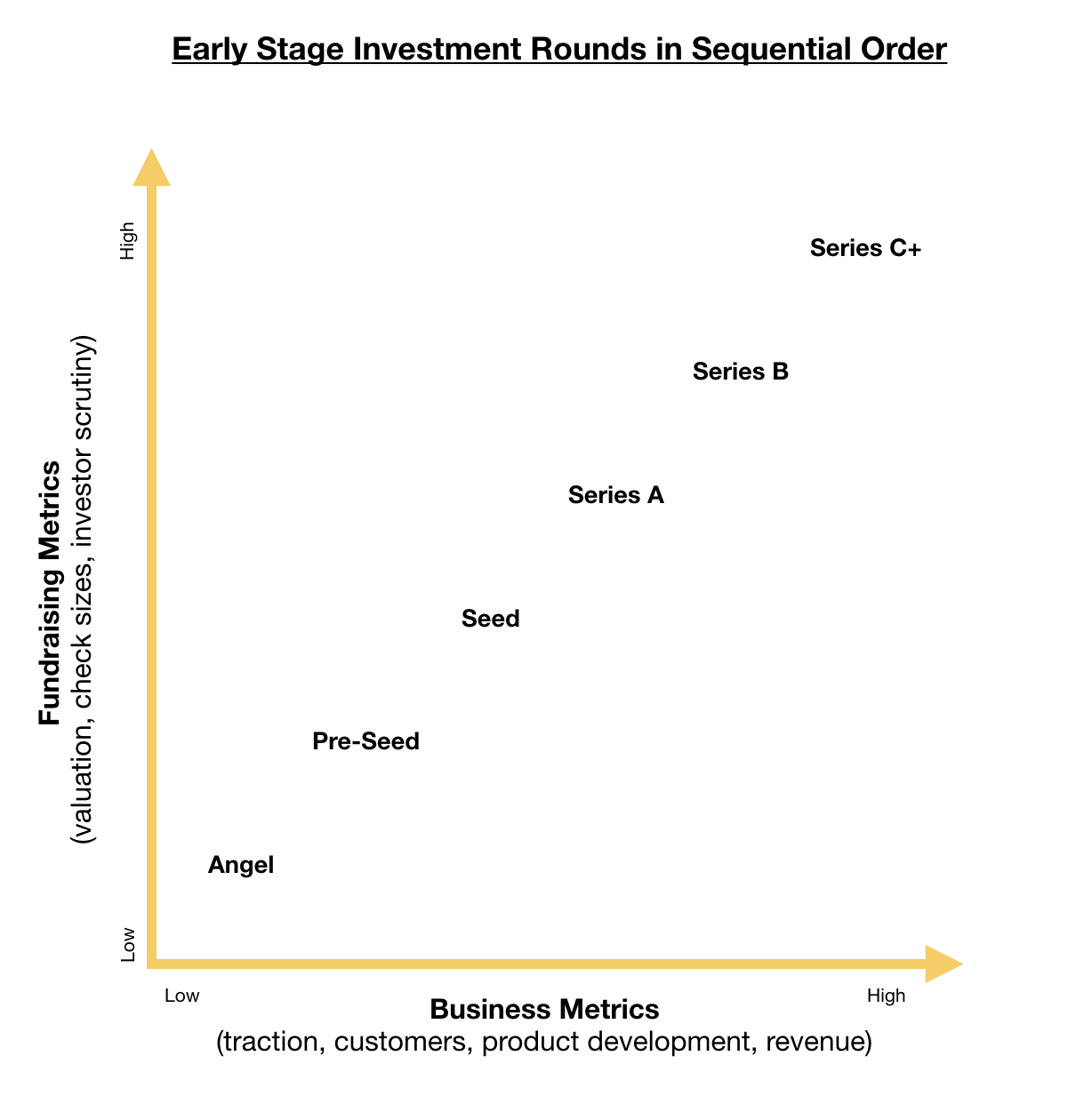Expert advice and real-world examples
It’s easy to be confused by the various startup funding stages, and no one can blame you — they are subjective. Use the blurred lines to your advantage by understanding the pros and cons of each category so that you can choose which stage you want to be considered, control the narrative accordingly, and get funded.
So how do you determine which funding stage you are, what investors to target, and how to build a pitch that will be successful? Let’s dive in.

Angel
As early as it gets, angel funding gives you the capital to turn your idea into a company. These people are called angels for a reason, as they give money often with little to go on but an idea or team. This group includes non-professional investors (like friends and family), mentors, newer investors, and dedicated angel investors. You can get away with more at this stage than with any other stage since you have nothing to show that can be fundamentally analyzed, but that comes with a price as you are selling equity at a lower valuation instead of showing some traction first and then raising at a higher valuation.
How to stand out:
- Business storytelling IS the company at this stage. Build a compelling reason for why your company needs to exist: Why Now, Why You, and Why and How this company is going to make a great investment.
- Even if your at-launch or first-year idea is niche, dream bigger and share your long-term vision for the company. That idea is what you need investors to get excited about.
- An idea is simply an idea, it comes down to execution. Build a convincing argument for why you (the founder) are going to be able to execute on this idea successfully.
Pre-Seed / Seed
Founders call their first round of funding either Angel, Pre-Seed, or Seed depending on an increasing scale of the founder’s relevant experience and target fundraising amount. This is generalized, but first time founders may call their first round “Angel” if they’re raising up to $500K, or “Pre-Seed” if they’re raising up to $1M. Meanwhile, experienced founders may call their first round “Seed” and raise $2M+. If a founder bootstrapped through the idea stage to MVP, she may call her first round of financing Seed since the company is further along.
Be aware that you can’t go backwards, meaning if your first round of funding is “Seed”, your next round has to be “Series A”. Series A rounds are less forgivable than prior rounds, so if you are less experienced, or are targeting a $750k-$2M raise it is safer to call a raise “Pre-Seed” in order to give yourself room for a Seed round ahead of a Series A.
So what is the major difference at this stage? The introduction of dedicated venture funds— pooled investment funds run by professional investors who are actively seeking startup investments based on a set of predefined criteria. VC associates are paid to source deals, so don’t be too excited if one agrees to a meeting, but do be excited if the Partner does.
Example investors: Hustle Fund (Pre-seed), First Round Capital (Pre-seed/Seed), Lerer Hippeau and NextGen (Seed).
How to stand out:
- If you’re at idea stage, follow the same tips as “Angel” above, but also invest in preliminary design (branded pitch deck, product mockups) which will help make your idea feel like a real company.
- Show that you’ve made effective use of the initial capital you raised (or spent via bootstrapping) by giving a sense that you’ve accomplished “a lot” with “a little” in a “Key Accomplishments” page in your deck.
- Build a robust financial model, and include key assumptions and revenue projections in your deck. Some founders skip this and get questioned after their pitch, my founders get ahead of it by going overboard on detail at this stage so that no one has questions to ask (regarding the forecast performance).
Series A
At Series A, your company can no longer be conceptual— you have to show that you are “gaining traction” and making progress with the outside world (i.e. customers, partners, initial revenue). You must show traction, so find a way to package and present your performance in a way that demonstrates progress— I had a client going for Series A who had limited revenue traction. We re-positioned their initial sales as a ‘successful’ limited run pilot.
The size of a Series A raise has been increasing steadily but is typically $10-15M. Example investors: RRE (they also do Seed), Rosecliff (Series A+)
How to stand out:
- Clearly articulate your growth plans, including the targets you plan to hit, and the drivers along the way that will get you there.
- Outline how you’ll utilize this fundraise to invest in the key areas that will take you to the next fundraising stage.
Series B
A company raising a Series B has either been in the market or fully operational for at least a year. Series B companies typically have customers, revenue, and teams of 20+. They also have a history of Key Performance Indicators (“KPIs”) that show via real data how the company is performing and tracking to its goals. To be successful at this stage, your KPIs should be trending in the right direction, ideally with “hockey stick” growth..
Series B raises tend to be $25M to $50M. Example investors: Andreesen Horowitz, Bessemer, USV
How to stand out:
- Show that you’re a good steward of investor capital by storytelling how, with each prior stage of funding, you’ve accomplished so much, exceeding expectations.
- If you’re B2B, try to categorize your customers into a few different buckets, and get compelling testimonials within each category.
- Focus on results, metrics/numbers that prove that you are succeeding without even requiring an explanation.
Series C and beyond
These extended rounds are called later-stage investment. By now, a company has a proven business model and needs additional funding to rapidly scale. Investors that enter the mix at C and beyond include hedge funds, investment banks, and private equity firms. Very late stage investors are investing large sums, looking for a shorter time period to collect their return, and potentially an IPO. A company raising a Series C or later could use the funds to buy out a competitor or expand into a new territory, for example.
Companies raising beyond a Series C may do so to continue to boost their valuation before an IPO or to hit targets set out in a prior fundraise.
How to stand out:
- Demonstrate your rock-solid business model and make it clear to investors how they will see a significant return in a relatively short amount of time.
- Consider setting up your pitch deck to go through your investment highlights, instead of the typical startup Problem/Solution method, as your problem and solution have already been proven out.
- Consider what major risk factors are preventing you from achieving your growth plan and make sure to mitigate them in your investor materials.
Wildcards
If you need to fundraise between rounds, there are official terms for that as well. Why would this ever occur? Keep reading, it can be considered either positive or negative depending on the circumstances. Of course, as a professional business storyteller, I believe there’s a way to put a positive spin on everything.
Extension:
An Extension (i.e. Series A Extension) occurs when a company raises more money after they’ve closed a round, with the same terms (like pricing and valuation) as that round. This might occur when an impressive investor who initially said “no”, changes their mind soon after and wants to come in, let’s say because of a change in market dynamics. It’s similar to “oversubscribing” a round, except it occurs after the round has closed, hopefully not too far after or one could argue that the terms should increase.
How to position:
- Narrate to existing investors why this new investor will add tremendous value for the company.
- If all is pretty much on track, but you discovered that more capital could be useful, be clear on what that additional capital will help the company achieve and why it will make the terms for your next round even better.
Bridge Round:
A Bridge is intermediary capital brought on to “bridge” a company to its next round. The decision could be offensive— to strengthen a company’s position ahead of the next round, or defensive— to keep the company afloat ahead of the next round (because it would otherwise run out of cash). It can come with less favorable terms than the prior round (called a “down round”), but not necessarily. Bridges occur when a company needs more cash for a variety of factors like a delayed go to market, higher than expected expenses, lower than expected sales, or the world shutting down (COVID-19).
How to position:
- A detailed turnaround plan that shows how each major bucket of the fundraise will go towards fixing the problem that 1) got the company into an unfavorable situation, and 2) will successfully get them to the next fundraising round, or…
- An explanation of why this is a healthy company that would benefit from holding on a full fundraising round by raising this smaller amount of cash.
- A story that makes it appear somewhat if not entirely positive, and backs up why this raise is a special situation.
In Summary:
Educate yourself on the available startup equity financing options ahead of beginning a process. Doing so will allow you to better prepare your pitch and long term business planning so that you can hit your fundraising goals.

